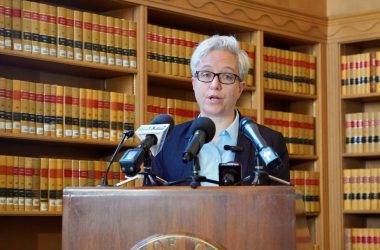Legislative leaders are forming a committee to drill into problems with Oregon’s addiction crisis amid heavy criticism of the state’s landmark drug decriminalization law and the threat of a well-funded ballot measure campaign to undo key parts of the law.
Senate President Rob Wagner and House Speaker Dan Rayfield said in a news release that the committee of House and Senate members will look at what law enforcement needs to keep cities and rural areas safe and the availability of treatment services to help those struggling with alcohol or drug abuse.
The announcement came right before a meeting of the House Behavioral Health and Health Care Committee, which spent 90 minutes discussing Measure 110, the state’s drug decriminalization law. Lawmakers heard updates from Oregon Health Authority managers and others on developments in the law’s implementation. Committee chair Rep. Rob Nosse, D-Portland, noted the creation of the joint committee while hearing presentations about Measure 110’s rollout.
The committee will meet for the first time in coming weeks, with regular public meetings until the 2024 legislative session starts in February.
Wagner and Rayfield nominated eight people to the committee, including health care, judicial leaders and party leaders: Senate Minority Leader Tim Knopp, R-Bend; Rep. Rob Nosse, D-Portland and chair of the House Behavioral Health and Health Care Committee; Sen. Floyd Prozanski, D-Eugene and chair of the Senate Judiciary Committee; Rep. Jason Kropf, D-Bend, chair of the House Judiciary Committee; Republican Reps. Christine Goodwin of Canyonville and vice-chair of the House behavioral health committee and Kevin Mannix of Salem; Democratic Rep. Andrea Valderrama of Portland; and Senate Majority Leader Kate Lieber, D-Beaverton.
Kropf and Lieber will co-chair the committee. Lieber is a former prosecutor who’s also served on Oregon’s psychiatric review board, which oversees people judged guilty of a crime except for insanity. She told the Capital Chronicle in an interview that the committee has to address two areas.
“We’ve got to figure out how to give police officers tools that they need and the whole criminal justice system to go after the dealers, after the cartels, and to really stem the supply,” she said. “We also have a demand problem, right? We have too many people who are addicted. We have a system that’s been underfunded for decades, and we need to figure out how to make sure that we have treatment for people who need it when they need it.”
She said the state needs a “gap analysis” to identify holes in the system and “to figure out funding.”
Measure 110, which decriminalized possession of small amounts of illegal substances and allocated money for addiction-related services, is funded by marijuana taxes. So far, the Oregon Health Authority, which oversees the system, has distributed more than $260 million to over 230 programs across the state.
Range of services
Kristen Donheffner, who oversees implementation of Measure 110 services at the health authority, told the behavioral health committee Friday that providers are shifting from establishing programs to providing services. They range from addiction treatment to housing and employment assistance to harm reduction, which essentially involves keeping people alive and safe while they abuse drugs or alcohol.
The health authority’s dashboard on the law’s implementation shows that a higher number of people have obtained harm reduction services than each of the other services but that treatment and support from peers, who are in recovery, account for the highest number of “encounters.” Donheffner said an encounter is defined as one service, for example, the distribution of clean needles to one person.
“Decades of research has shown a significant public health benefit to harm reduction, everything from preventing deaths to lowering disease transmission in our provider,” Donheffner testified. “Harm reduction providers provide a range of these services from naloxone to wound care, and our providers are really at the front lines of the epidemic.”
In terms of spending, she said more money has gone toward housing, peer support and treatment.
Donheffner noted the number of people served grows every quarter, with the largest gains in housing and supported employment services.
“I call those out because those are two services that are not funded by Medicaid or insurance,” she said. “Measure 110 is really filling a gap that exists in our continuum of care for treatment services.”
The dashboard does not show – and the health authority does not appear to be tracking – how many people have been helped to get off drugs. It has six people dedicated to administering contracts and reviewing quarterly expense reports, Donheffner said, who indicated they have not cracked down on any providers. However, the oversight committee that awards contracts has rescinded three – not because the health authority intervened but because insiders complained about misused funds, the Capital Chronicle reported.
Donheffner confirmed that those were the only contracts that have been terminated. She said the authority aims to support programs that have received funds, not end them.
“Our team has been working hard to keep these dollars in the community,” Donheffner said. “We see grant termination as a very last resort.”
Calls for change
While the health authority continues to oversee the Measure 110 rollout, criticism has grown over the law, and some Republicans and law enforcement officers have called for its termination.
Knopp, the Senate Republican leader, said in a statement that his caucus will ask the committee to refer a bill on Measure 110 to voters.
“Now it is the Legislature’s job to hear voters and respond to their concerns,” Knopp said.
A similar statement from the House Republican caucus blasted Democrats for not listening to Republican concerns about Measure 110 during the session.
“While Republicans are happy to see movement on the issue, they are concerned it may (be) too little, too late,” a statement said.
A well-funded coalition that includes Nike co-founder Phil Knight, has filed two ballot measures with the Secretary of State’s Office to prohibit public use of drugs, recriminalize possession, force people on drugs or alcohol to get treatment and expand prevention, treatment and recovery services.
Dharma Mirza, co-chair of the Measure 110 oversight committee, said during the hearing that only the latter approach would stem the state’s drug addiction crisis.
“It’s just jarring to me that folks would think that a repeal or lowering our funding of these kinds of things would somehow get us there, because it won’t,” Mirza testified. “The reality is that we need an expansion of these services.”
She said Measure 110 needs more time to work.
“There’s not been enough time to adequately assess the impact of Measure 110,” Mirza said. “There’s a lot of misguided attempts to criminalize drug usage over small possession based on a limited understanding of how decriminalization works.”
A recent study indicated that a rise in overdoses in Oregon cannot be linked to Measure 110, though another study suggested the opposite. But the public – and lawmakers – clearly want the law tweaked.
Gov. Tina Kotek recently called on police to crack down on fentanyl dealers. The drug, 100 times more potent than morphine, is responsible for many of the overdoses in Oregon, including among young people. This week, Portland police announced that since mid-June 10 young people had overdosed, and five of them had died. The fatalities were 1 years old, 2 years old and 5 years old and two were 15 years old. Fentanyl was suspected in all but one of the cases, police said.
The problem is not just in Oregon. Heather Jefferis, executive director of the Oregon Council for Behavioral Health, told the committee that fentanyl is a nationwide problem, noting it was the number one cause of accidental death in Pennsylvania.
Experts say the epidemic is likely to get even worse in Oregon.
“We’re chasing a tsunami, and it’s a tsunami that is not just in Oregon, it’s across the country,” Lieber said. “It has really, really ramped itself up.”
Oregon Capital Chronicle is part of States Newsroom, a network of news bureaus supported by grants and a coalition of donors as a 501c(3) public charity. Oregon Capital Chronicle maintains editorial independence. Contact [email protected]. Follow Oregon Capital Chronicle on Facebook and Twitter.




